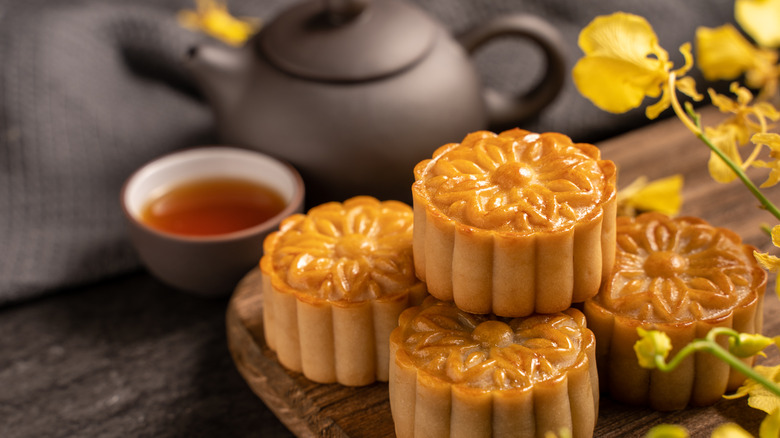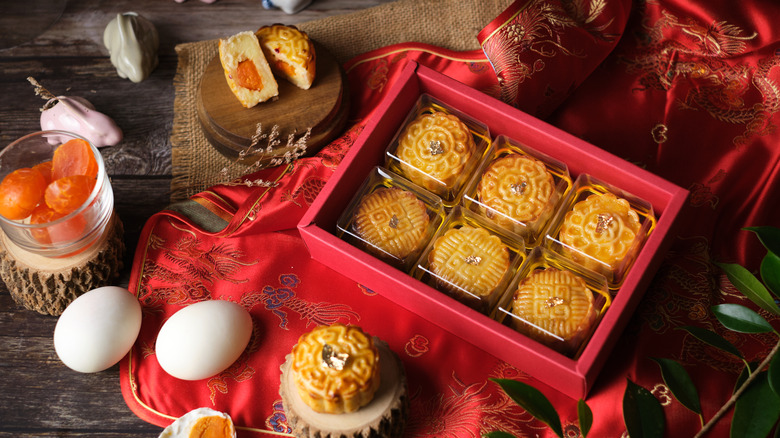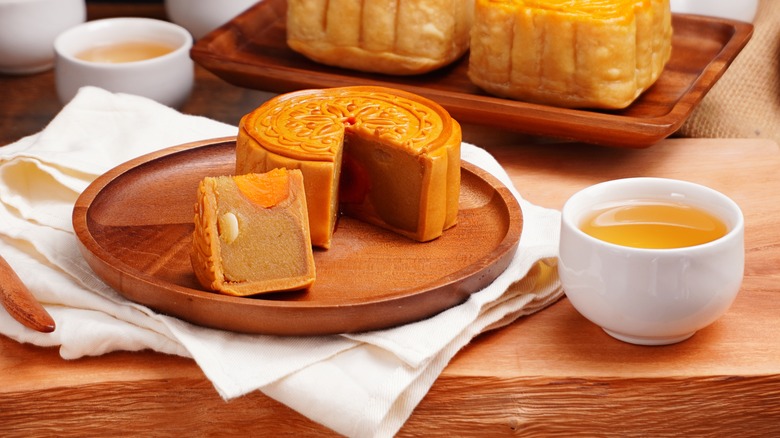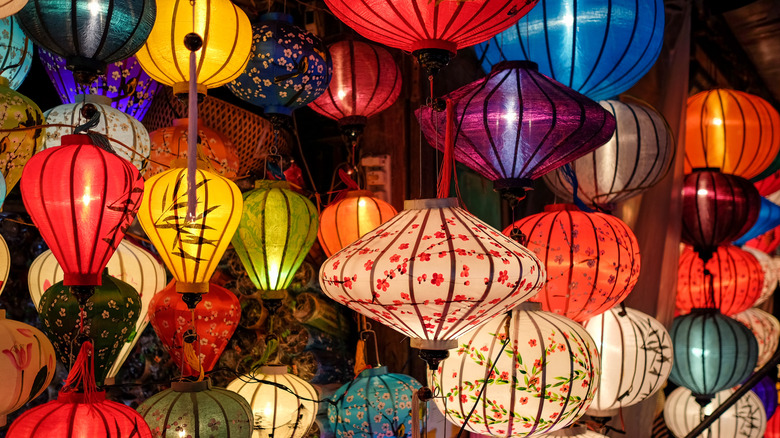What Are Mooncakes And When Do You Eat Them
There is often limited room for bakers to innovate where a festive pastry like the mooncake is concerned, whose recipe dates back centuries. Tradition dictates that mooncakes come in a variety of stodgy fillings, ranging from a mixed-nut option — made with a blend that might incorporate sesame seeds, walnuts, melon seeds, hawthorn, and almonds – to other varieties including red bean, salted egg, white lotus, and minced pork options, per Travel China Guide. But mooncakes can come with more modern fillings too, including fruit, yam, and flowers, as well as custard, chocolate, coffee, and matcha, which are sold by trendier bakeries and restaurants, per Time Out.
No matter what these fillings might be, mooncakes are normally encased in a thin pastry that can be browned and chewy, made with lard and flaky, or pale white and reminiscent of mochi, per Bakestarters. They also don't usually come in too many different shapes –they're typically either round as the moon, or slightly square-shaped, per Today. And despite the different varieties of mooncakes on offer, it is the traditional Cantonese version of this seasonal pastry that is most common, which is filled with a paste made from salted duck egg yolk and lotus seeds, per Catherine Zhang.
Mooncakes have been compared to Western fruitcakes
Historical sites like Atlas Obscura say mooncakes are to Asians what Christmas fruitcakes are to Western cultures. And similar to Western attitudes to fruitcake, food blogger Suzanne Nuyen told Today, "I feel like mooncakes are a very polarizing food. You either love them or you hate them." No surprises, then, that The Standard says that the people of Hong Kong chose to throw out 2.88 million mooncakes in 2020 simply because they didn't like them. It doesn't help that thanks to its high fat and sugar content, a traditional mooncake can have a minimum of 716 calories, per The Straits Times.
Even though they can be made at home, with sites like Catherine Zhang providing recipes and tips, most mooncakes are purchased from bakeries that specialize in making them, simply because they can be time-consuming to make from scratch. One baker even told Today it could take up to eight hours to make a single batch.
Travel China Guide says mooncakes first made an appearance about 3,000 years ago, and for a time, they were meant to be used as an offering to mark the Mid-Autumn Festival. The actual practice of eating mooncakes didn't come about until the Tang Dynasty, which ruled China between 618 to 907 AD, and it didn't become common practice until late Yuan Dynasty, which lasted from 1271 to 1368 AD.
Eating mooncakes is a centuries-old tradition
Mooncakes are consumed every year on the 15th day of the eighth month of the lunar calendar, which falls on September 10 this year. For those who celebrate, the Mid-Autumn Festival is an important time for families to get together, and ranks second only to the Spring Festival, which is also the same time when the Lunar New Year occurs, per China Travel. Bakery executive Arthur Kao told Today, "For a lot of Asian Americans, for all of us who are born here, and also came here, the Mooncake Festival means a lot to us. It's like our Thanksgiving, time to hang out as you would, stress-free with your family and really share that space."
While it is meant to be a day of celebration for a successful fall harvest, there are different stories associated with Mid-Autum Festival, too. One tale involves the origin story of moon goddess Chang'e, who drank a magic elixir to keep it from falling into the wrong hands. The medicine made the woman so light that she floated to the moon, where she hangs out with a Jade Rabbit, per CNN.
Mooncakes have a political myth that surrounds them as well. Atlas Obscura notes that the founder of the Ming Dynasty, Zhu Yuanzhang, and his friend Liu Bowen plotted to overthrow China's Mongol overlords by hiding messages about the uprising inside the cakes and delivering them to the people, but there is no proof that this ever actually happened.
Cultural importance of the Mid-Autumn Festival
The Mid-Autumn Festival is observed by Asian cultures that also follow the lunar calendar, but the event has different significance in various countries. In Vietnam, for instance, Suzanne Nuyen tells Today that the festival is seen as a children's festival. She adds: "People will light lanterns and kids will go out for the parade. And it's been a lot of fun seeing what the holiday means for different Asian cultures. I don't think it's a children's holiday in China. It's just all about spending time with your family and celebrating the start of autumn and admiring the big, full moon."
Common traditions that surround the celebration of Mid-Autumn Festival also include the lighting of festive paper lanterns and watching lucky lion dances, per CNN. Practices also differ slightly in South Korea, where people take advantage of a three-day holiday to visit the tombs of their ancestors; while in Japan, the festival is marked by eating grilled rice balls while taking part in moon-viewing parties.



